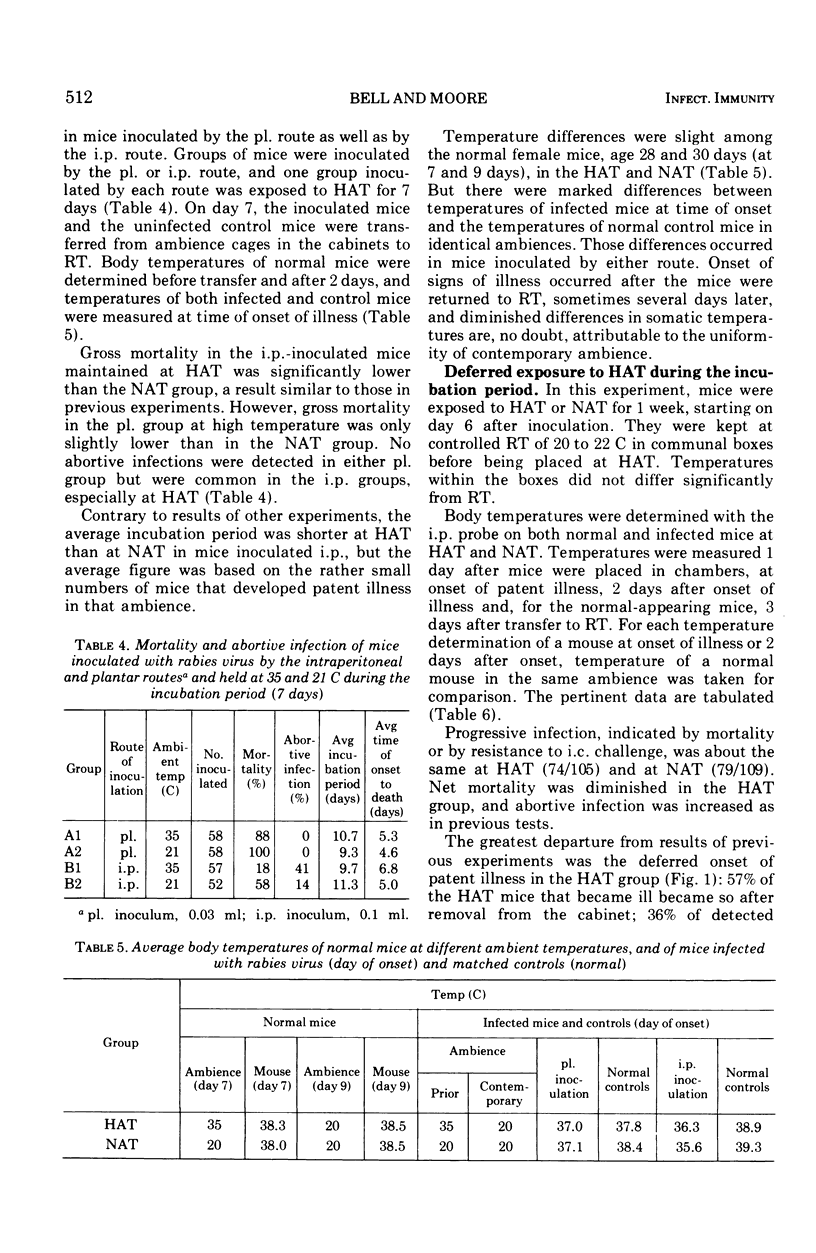Abstract
Effects of high ambient temperatures on various stages of rabies virus infection have been studied. Ambient temperature increased within the tolerated range was found to have little effect upon body temperature of normal mice, but caused marked elevation of temperature during illness. Temperatures at onset of patent illness in mice were lower than normal. Increased body temperature in the higher thermic ambience during the incubation period was associated with decreased mortality and frequent abortive infections. Exposure to high ambient temperature late in the incubation period delayed onset of illness, decreased mortality, and increased frequency of abortive infections, but exposure to high ambient temperature after onset of patent illness did not affect the course of the disease.
Full text
PDF





Selected References
These references are in PubMed. This may not be the complete list of references from this article.
- BARON S. MECHANISM OF RECOVERY FROM VIRAL INFECTION. Adv Virus Res. 1963;10:39–64. doi: 10.1016/s0065-3527(08)60696-x. [DOI] [PubMed] [Google Scholar]
- BEDSON H. S., DUMBELL K. R. The effect of temperature on the growth of pox viruses in the chick embryo. J Hyg (Lond) 1961 Dec;59:457–469. doi: 10.1017/s0022172400039152. [DOI] [PMC free article] [PubMed] [Google Scholar]
- BELL J. F. ABORTIVE RABIES INFECTION. I. EXPERIMENTAL PRODUCTION IN WHITE MICE AND GENERAL DISCUSSION. J Infect Dis. 1964 Jun;114:249–257. doi: 10.1093/infdis/114.3.249. [DOI] [PubMed] [Google Scholar]
- Beisel W. R. A role for glucagon during infection. N Engl J Med. 1973 Apr 5;288(14):734–735. doi: 10.1056/NEJM197304052881411. [DOI] [PubMed] [Google Scholar]
- Bell J. F., Gonzalez M. A., Diaz A. M., Moore G. J. Nonfatal rabies in dogs: experimental studies and results of a survey. Am J Vet Res. 1971 Dec;32(12):2049–2058. [PubMed] [Google Scholar]
- Bell J. F., Sancho M. I., Diaz A. M., Moore G. J. Nonfatal rabies in an enzootic area: results of a survey and evaluation of techniques. Am J Epidemiol. 1972 Feb;95(2):190–198. doi: 10.1093/oxfordjournals.aje.a121384. [DOI] [PubMed] [Google Scholar]
- CLARK H. F., SHEPARD C. C. EFFECT OF ENVIRONMENTAL TEMPERATURES ON INFECTION WITH MYCOBACTERIUM MARINUM (BALNEI) OF MICE AND A NUMBER OF POIKILOTHERMIC SPECIES. J Bacteriol. 1963 Nov;86:1057–1069. doi: 10.1128/jb.86.5.1057-1069.1963. [DOI] [PMC free article] [PubMed] [Google Scholar]
- Clark H. F., Wiktor T. J. Temperature-sensitivity characteristics distinguishing substrains of fixed rabies virus: lack of correlation with plague-size markers or virulence for mice. J Infect Dis. 1972 Jun;125(6):637–646. doi: 10.1093/infdis/125.6.637. [DOI] [PubMed] [Google Scholar]
- DEPOUX R. INFECTION DES CELLULES DE GLANDE SOUS-MAXILLAIRE DE CHIEN CULTIV'EES IN VITRO PAR UN VIRUS RABIQUE FIXE. Can J Microbiol. 1964 Aug;10:527–534. [PubMed] [Google Scholar]
- Enright J. B., Franti C. E., Frye F. L., Behymer D. E. The effect of altering metabolic rate on the mortality and incubation time of rabies. Proc Soc Exp Biol Med. 1968 Apr;127(4):1111–1116. doi: 10.3181/00379727-127-32884. [DOI] [PubMed] [Google Scholar]
- FELDMAN W. H., KARLSON A. G., HERRICK J. F. Mycobacterium ulcerans; pathogenesis of infection in mice, including determinations of dermal temperatures. Am J Pathol. 1957 Nov-Dec;33(6):1163–1179. [PMC free article] [PubMed] [Google Scholar]
- Hattwick M. A., Weis T. T., Stechschulte C. J., Baer G. M., Gregg M. B. Recovery from rabies. A case report. Ann Intern Med. 1972 Jun;76(6):931–942. doi: 10.7326/0003-4819-76-6-931. [DOI] [PubMed] [Google Scholar]
- Huxsoll D. L., Hemelt I. E. Clinical observations of canine herpesvirus. J Am Vet Med Assoc. 1970 Jun 15;156(12):1706–1713. [PubMed] [Google Scholar]
- KISSLING R. E., REESE D. R. ANTI-RABIES VACCINE OF TISSUE CULTURE ORIGIN. J Immunol. 1963 Sep;91:362–368. [PubMed] [Google Scholar]
- Kirn A., Schieffer K., Braunwald J. L'hyperthermie provoquée au cours de l'encéphalite à virus vaccinal de la souris. Mécanisme de son action. Ann Inst Pasteur (Paris) 1966 Dec;111(6):645–654. [PubMed] [Google Scholar]
- LWOFF A. Factors influencing the evolution of viral diseases at the cellular level and in the organism. Bacteriol Rev. 1959 Sep;23(3):109–124. doi: 10.1128/br.23.3.109-124.1959. [DOI] [PMC free article] [PubMed] [Google Scholar]
- Lycke E., Hermodsson S., Kristensson K., Roos B. E. The herpes simplex virus encephalitis in mice at different environmental temperatures. Acta Pathol Microbiol Scand B Microbiol Immunol. 1971;79(4):502–510. doi: 10.1111/j.1699-0463.1971.tb03801.x. [DOI] [PubMed] [Google Scholar]
- Postic B., DeAngelis C., Breinig M. K., Monto H. O. Effect of temperature on the induction of interferons by endotoxin and virus. J Bacteriol. 1966 Mar;91(3):1277–1281. doi: 10.1128/jb.91.3.1277-1281.1966. [DOI] [PMC free article] [PubMed] [Google Scholar]
- ROBERTS J. A. HISTOPATHOGENESIS OF MOUSEPOX: III. ECTROMELIA VIRULENCE. Br J Exp Pathol. 1963 Oct;44:465–472. [PMC free article] [PubMed] [Google Scholar]
- Rao D. S., Glick B. Immunosuppressive action of heat in chickens. Proc Soc Exp Biol Med. 1970 Feb;133(2):445–448. doi: 10.3181/00379727-133-34493. [DOI] [PubMed] [Google Scholar]
- SADLER W. W., ENRIGHT J. B. Effect of metabolic level of the host upon the pathogenesis of rabies in the bat. J Infect Dis. 1959 Nov-Dec;105:267–273. doi: 10.1093/infdis/105.3.267. [DOI] [PubMed] [Google Scholar]
- SCHMIDT J. R., RASMUSSEN A. F., Jr The influence of environmental temperature on the course of experimental herpes simplex infection. J Infect Dis. 1960 Nov-Dec;107:356–360. doi: 10.1093/infdis/107.3.356. [DOI] [PubMed] [Google Scholar]
- Selimov M. A., Nikitina L. F. Ob rct40-markere fibsirovannogo virusa beshenstva. Vopr Virusol. 1970 Mar-Apr;15(2):161–165. [PubMed] [Google Scholar]
- Shepard C. C. Temperature optimum of Mycobacterium leprae in mice. J Bacteriol. 1965 Nov;90(5):1271–1275. doi: 10.1128/jb.90.5.1271-1275.1965. [DOI] [PMC free article] [PubMed] [Google Scholar]
- Sodja I., Matouch O., Lím D. Isolation of rabies-like virus from murine rodents. J Hyg Epidemiol Microbiol Immunol. 1971;15(2):229–230. [PubMed] [Google Scholar]
- WEISKRANTZ L. Effects of medial temporal lesions on taste preference in the monkey. Nature. 1960 Sep 3;187:879–880. doi: 10.1038/187879b0. [DOI] [PubMed] [Google Scholar]


